An efficient logistics sales process forms the bedrock of sustainable growth for any enterprise. However, how can seamless coordination between the sales and logistics departments be ensured? The answer lies in an ERP system. The article "From Lead to Shipment: The Logistics Sales Process with ERP" will offer you a detailed insight into how ERP digitizes the logistics sales process, transforming complex tasks into simpler and more effective operations than ever before.
1. Order receiving
The freight request process commences upon receipt of the customer's service order via designated channels, including email, telephone, the company website, or our online booking platform. Our designated personnel will receive and validate the initial information to initiate order processing.
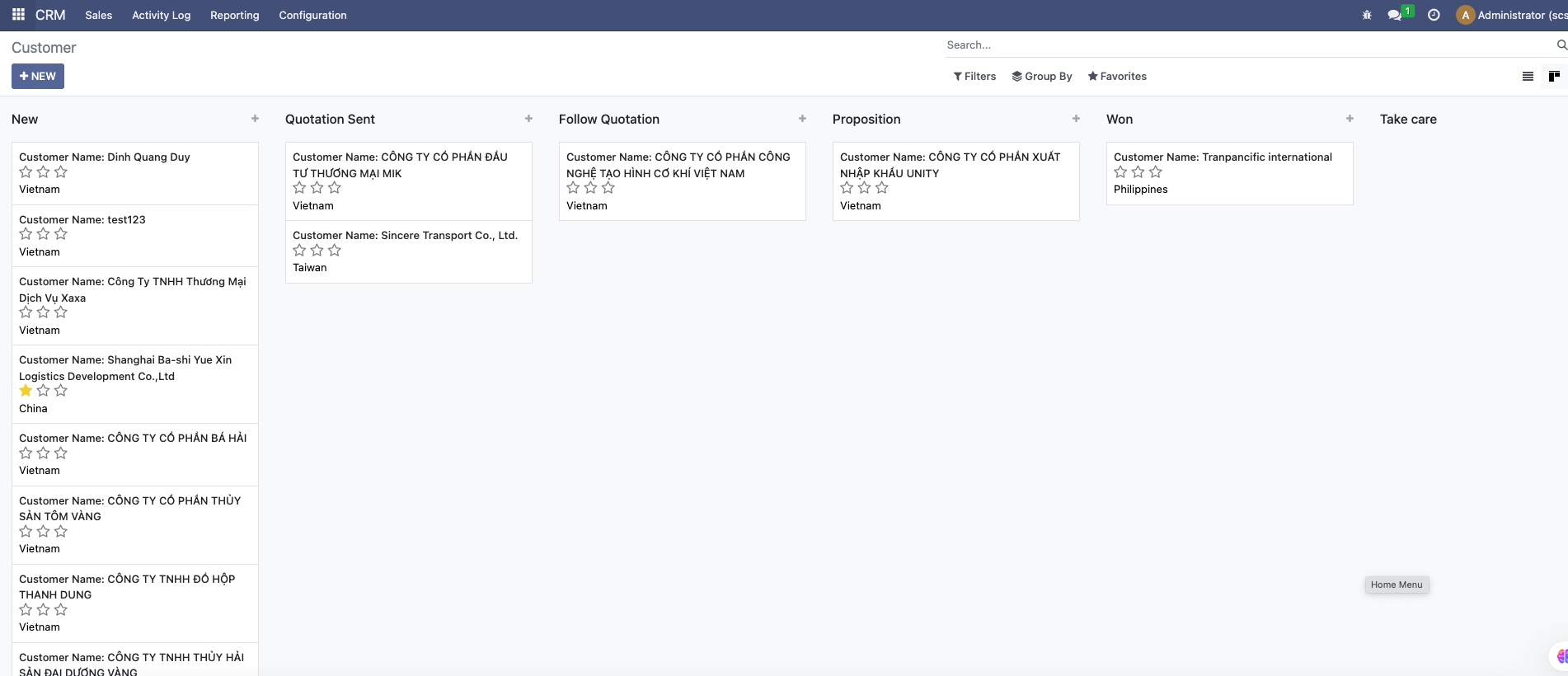
The requisite customer-provided information includes:
- Commodity Details: Comprehensive description of the goods, specifying nature (e.g., fragile, hazardous, temperature-controlled).
- Weight and Dimensions: Total cargo weight, volume, and number of units.
- Origin and Destination: Precise pick-up and delivery addresses, along with contact information at both locations.
- Required Transit Timeline: Anticipated pick-up date and desired delivery date.
- Transportation Mode: Based on requirements and cargo specifics, clients can select from options such as:
- Sea Freight: Full Container Load (FCL) or Less than Container Load (LCL) shipments.
- Air Freight: Suitable for time-sensitive or high-value cargo.
- Road Freight: Applicable for domestic or short cross-border routes.
- Special Instructions (if applicable): Examples include door-to-door delivery, consolidation, repacking, cargo insurance, quarantine, customs clearance, and other value-added services.
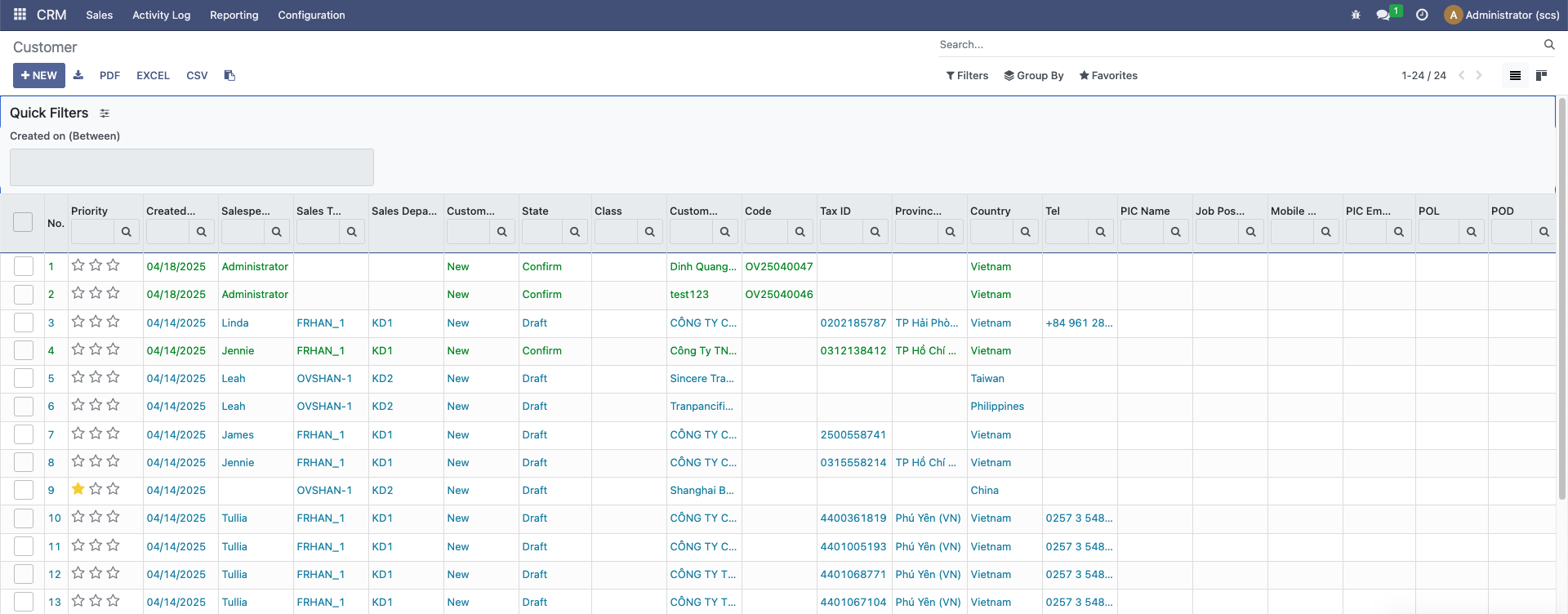
Upon complete information receipt, our dispatch or sales department will promptly assess feasibility, provide a quotation, and respond to the customer at the earliest opportunity.
2. Order verification and confirmation
Upon receipt of a customer request, the Sales or Customer Service department will proceed with a thorough verification and confirmation of all pertinent order details. This crucial step ensures the efficient and compliant execution of the requested services, aligning with agreed-upon commitments.
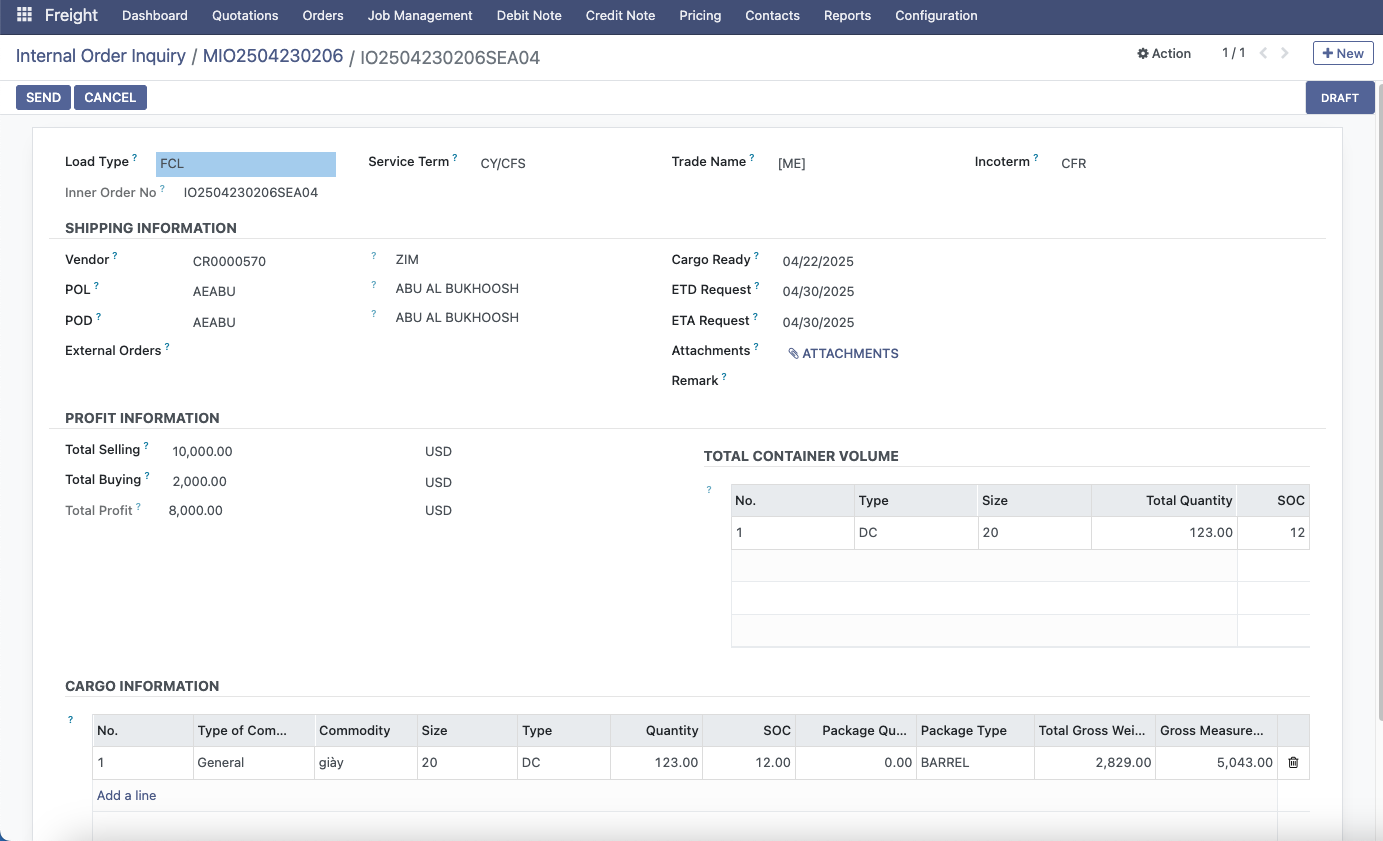
The specific stages within the verification process encompass:
Logistics capacity assessment:
- Verification of route suitability and feasibility (domestic, international, transshipment).
- Confirmation of the availability of appropriate transportation modes (trucks, containers, vessels, aircraft, etc.) corresponding to the cargo type and requested timeframe.
- Assessment of the ability to provide specialized equipment, if required (reefer containers, open-top containers, cranes, pallets, etc.).
Transportation conditions and regulatory compliance review:
- Ensuring transportation conditions align with the specific characteristics of the goods (dangerous goods, perishable goods, high-value goods, etc.).
- Verification of relevant legal requirements such as import/export licenses, quarantine certificates, Certificates of Origin (CO), Certificates of Quality (CQ), Material Safety Data Sheets (MSDS), etc.
- Determination of the necessity for cargo insurance and provision of suitable insurance options.
Agreement on transaction terms:
- Provision of a detailed quotation based on the information provided, including freight charges, surcharges, and value-added services (if applicable).
- Negotiation and clarification of payment terms (advance payment, deferred payment, transfer methods, or cash).
- Specification of the quotation validity period and conditions for price adjustments (if any).
➜ Following the customer's confirmation of agreement with the quotation and service terms, the relevant personnel will proceed with the formal order confirmation within the system.
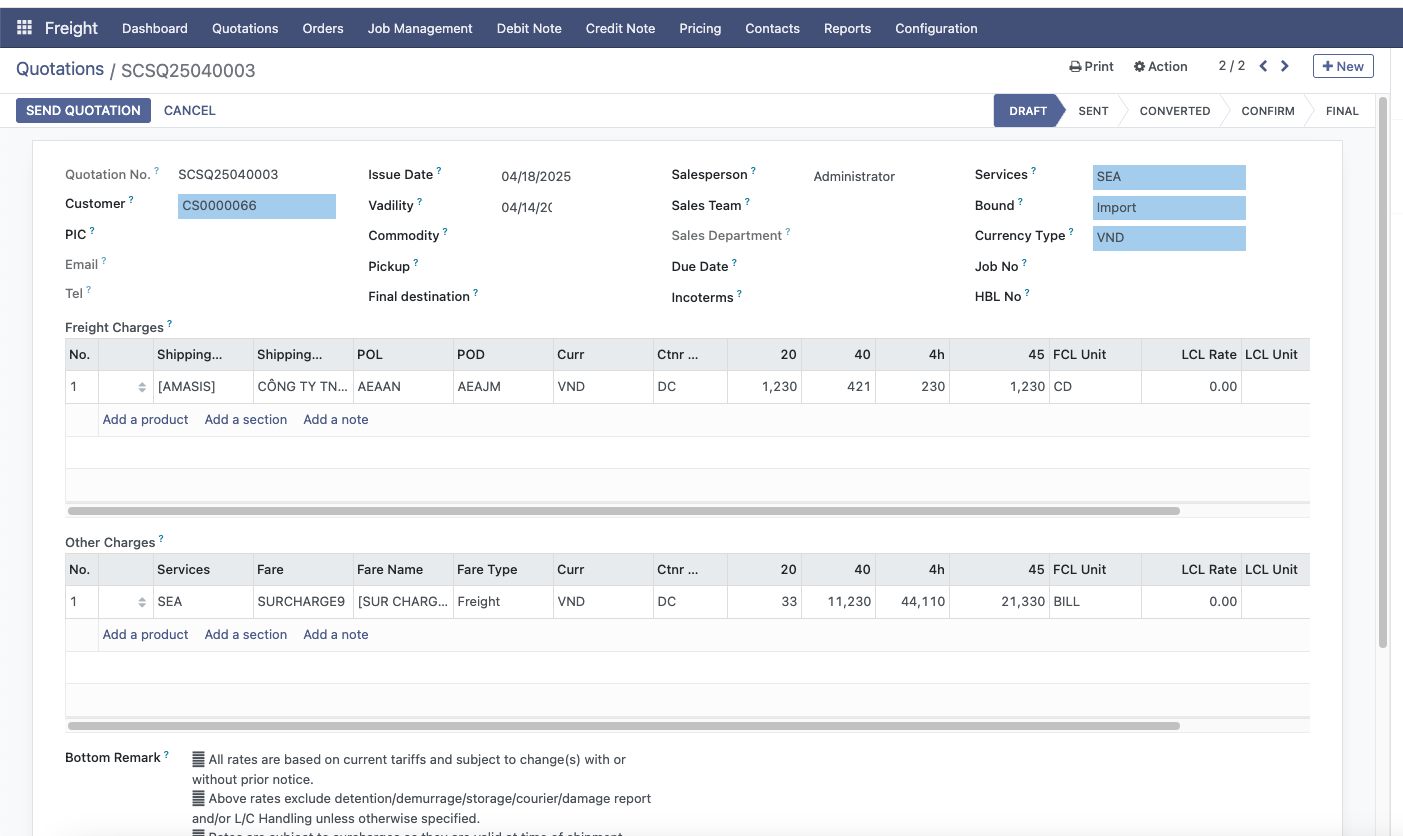
Order confirmation is a critical stage that ensures mutual understanding and agreement between both parties – the logistics provider and the customer – regarding the scope of services, associated costs, and respective responsibilities.
3. Operations planning and coordination
Following order confirmation, the Operations department will proceed with the development and execution of a detailed transportation plan. This ensures the timely and accurate movement of goods along the designated routes, meeting all specified customer requirements.
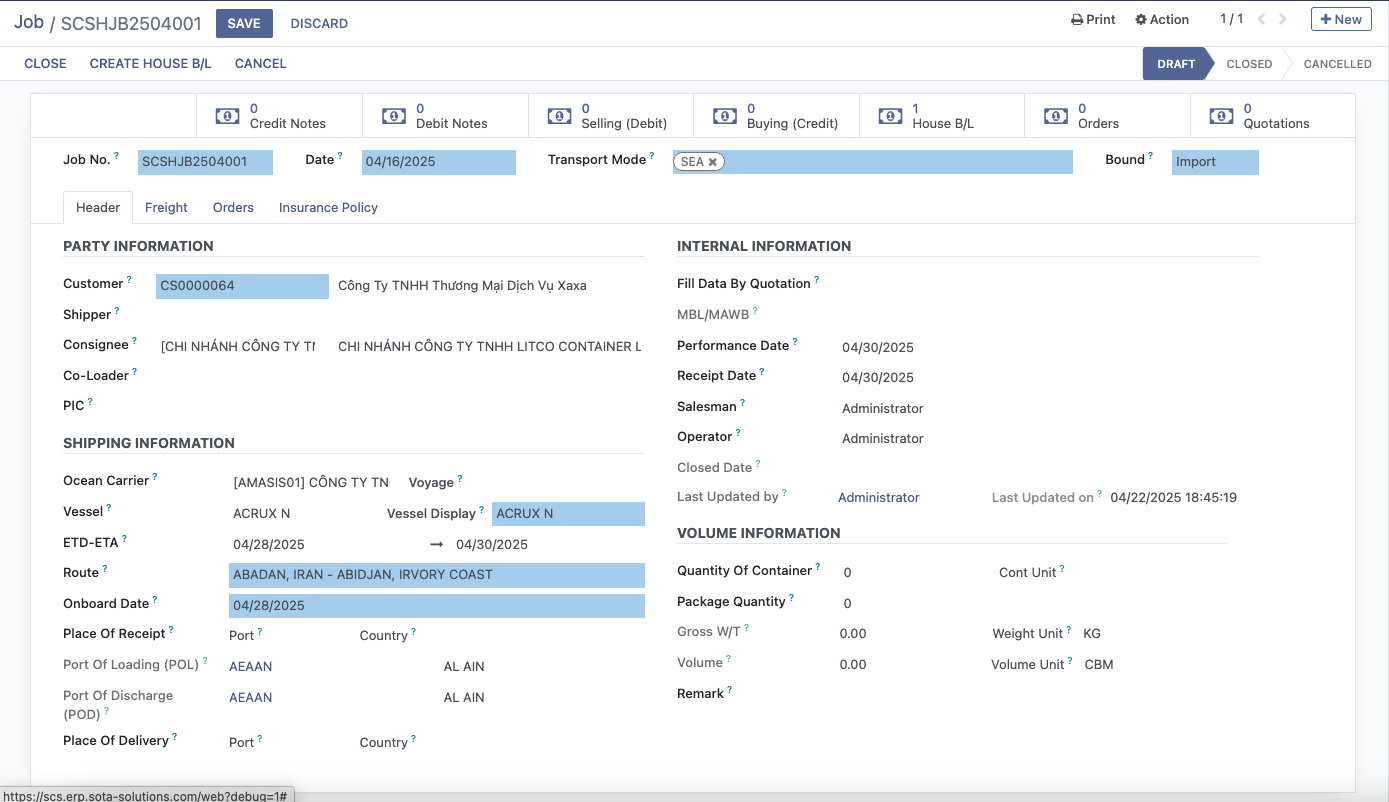
Key stages within the coordination phase include:
Detailed transportation planning:
Based on confirmed details regarding cargo type, routing, and delivery timelines, the coordination team will establish an optimized transportation schedule. This schedule will align with the appropriate service mode (FCL, LCL, Air, Road, etc.).
Booking:
- Secure bookings with suitable shipping lines, airlines, or road carriers.
- Confirm transportation capacity and ensure space availability according to the planned schedule.
- Verify and receive booking confirmation from the carrier to proceed with subsequent steps.
Vehicle and container allocation:
- Allocate appropriate domestic transport vehicles based on cargo weight, dimensions, and type.
- Arrange for the corresponding container type (standard, refrigerated, open-top, etc.) at the depot or port as required.
- Conduct technical inspections of vehicles prior to deployment.
Personnel assignment and procedure implementation:
- Pickup: Coordinate personnel for timely cargo pickup at the customer's warehouse/factory as requested.
- Packing (if applicable): Prepare necessary packing materials and organize professional packing in accordance with international shipping standards.
- Customs Declaration: Assign the documentation department to prepare the required documentation and proceed with electronic customs declarations (Export/Import Declaration).
- Other Procedures: Process documentation, apply seals and labels, and complete any special procedures as necessary (e.g., quarantine, fumigation).
All stages within the coordination process are subject to rigorous monitoring to ensure synchronization, timeliness, and the minimization of potential risks during transit.
4. Execute shipment & monitor transit
Following the completion of all preparatory tasks, the cargo is handed over to the transportation unit, officially commencing the shipment phase. The Operations department is responsible for closely monitoring the entire transit to ensure adherence to schedules and cargo safety, while maintaining regular communication with the client.
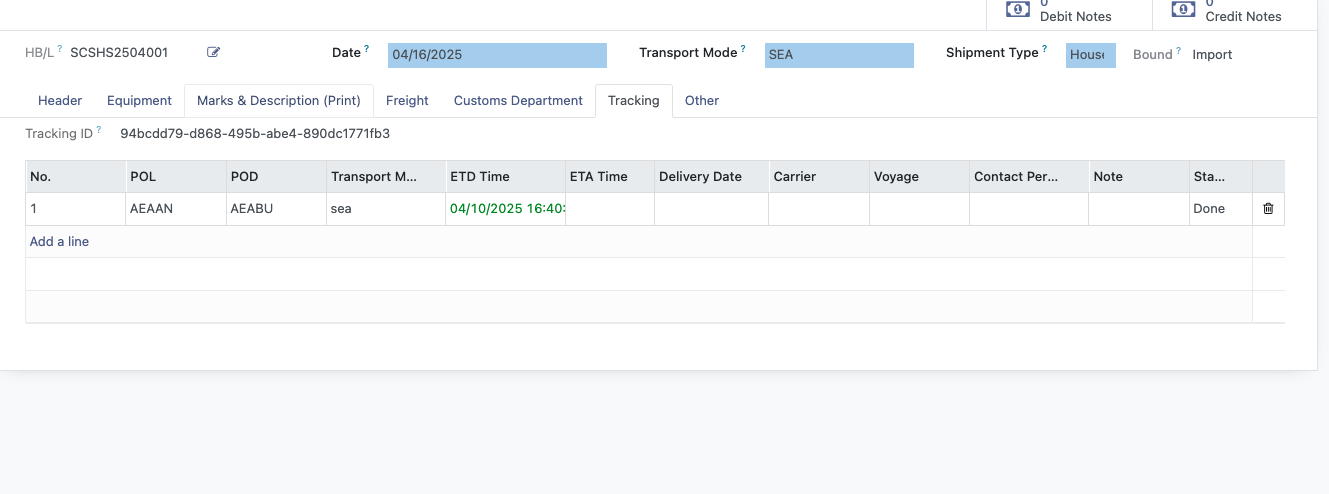
Key activities during this stage include:
Executing transportation according to schedule:
- Cargo is moved from the pickup location to the port, airport, or consolidation point as per the agreed-upon timeline.
- Ensuring timely handover of goods to the shipping line, airline, or transportation provider, accompanied by all necessary documentation.
- For domestic shipments, executing final delivery to the consignee at the agreed-upon location and time.
Continuously updating shipment status:
- Operations staff track and record key transportation milestones within the logistics management system, such as:
- Goods received from the customer.
- Handed over to the carrier.
- Goods are in transit.
- Undergoing customs clearance at origin/destination.
- Customs clearance completed.
- Goods delivered to the final destination.
- All updates are stored and synchronized within the system to ensure transparency and real-time visibility.
Providing tracking information to customers:
- Supplying the bill of lading number, tracking link, or periodic status updates via email, Zalo, or the customer's designated management platforms.
- Proactively informing customers of any arising issues, schedule changes, or requests for collaboration in resolving related matters.
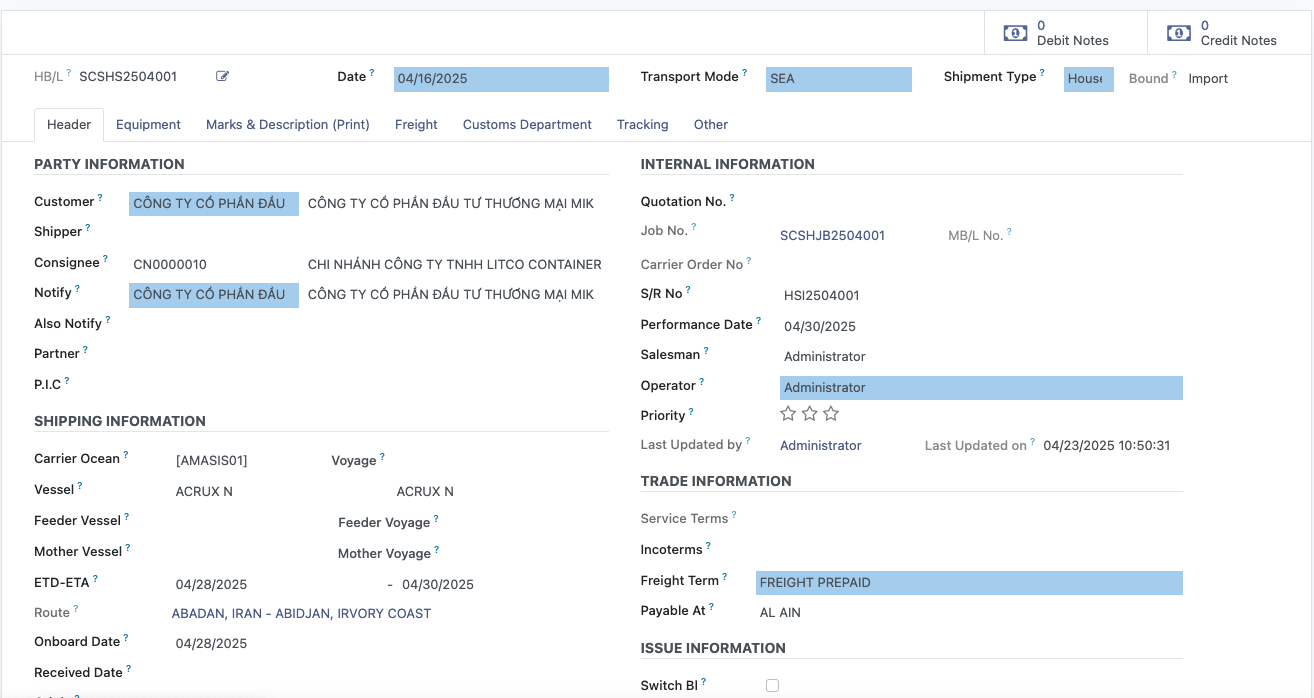
Timely tracking and communication provide customers with peace of mind throughout the shipping process, while demonstrating the professionalism and accountability of the logistics service provider.
5. Documentation preparation and submission
Documentation is an integral component of the international freight forwarding process, serving as legal evidence and facilitating customs clearance, payment processing, and confirmation of cargo ownership. Following the shipment of goods, the Documentation department will prepare and submit all pertinent documents to the client and other relevant parties.
Common shipping documents typically include:
Bill of Lading (B/L) / Air Waybill (AWB): This is the most critical shipping document, confirming receipt of goods by the carrier and establishing ownership.
- Bill of Lading (B/L): Utilized for ocean freight.
- Air Waybill (AWB): Utilized for air freight.
Commercial Invoice: This document details the value of the goods and serves as the basis for tax calculation and customs procedures.
Packing List: This provides a detailed breakdown of the quantity, dimensions, and weight of each individual package – used for verification during loading/unloading, customs clearance, and delivery.
Certificate of Origin (C/O): This certifies the country of origin of the goods, enabling preferential tariff treatment under trade agreements (where applicable).
Contracts, Authorizations, and Other Supporting Documents: These may include foreign trade contracts, import/export licenses, insurance certificates, quarantine certificates, Material Safety Data Sheets (MSDS), fumigation certificates, etc.
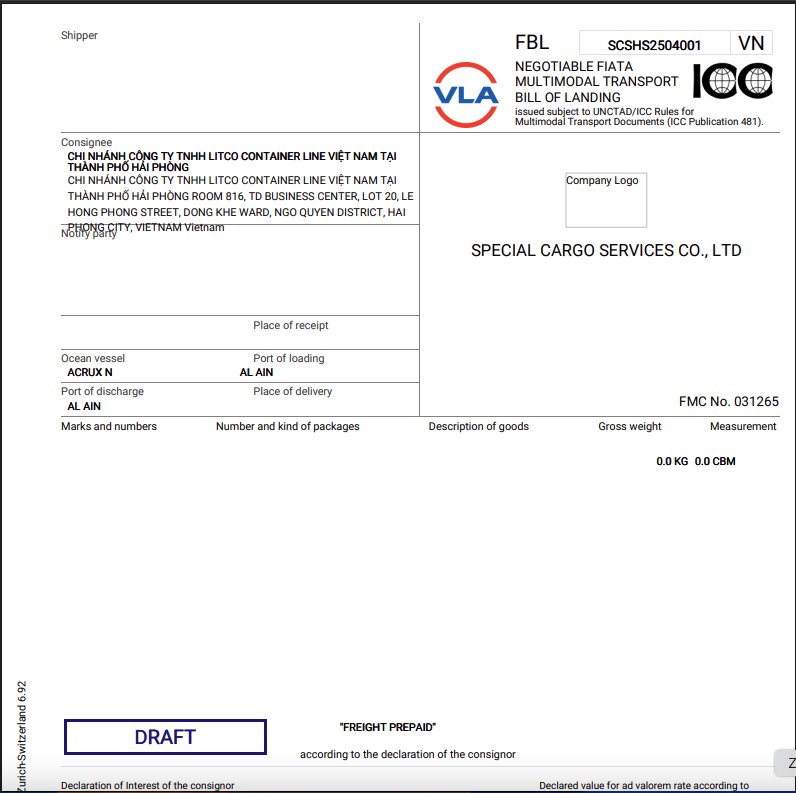
Submission of Documents to Stakeholders:
- Client: Receives a complete set of documents as the basis for customs declaration, international payment, or cargo receipt at the destination.
- Shipping Line / Forwarding Agent / Overseas Partner: Provided with advance scans or soft copies for operational processing prior to the dispatch of hard copies (if required).
- Bank (in case of L/C payment): Ensures strict compliance of documents with the terms and conditions of the Letter of Credit.
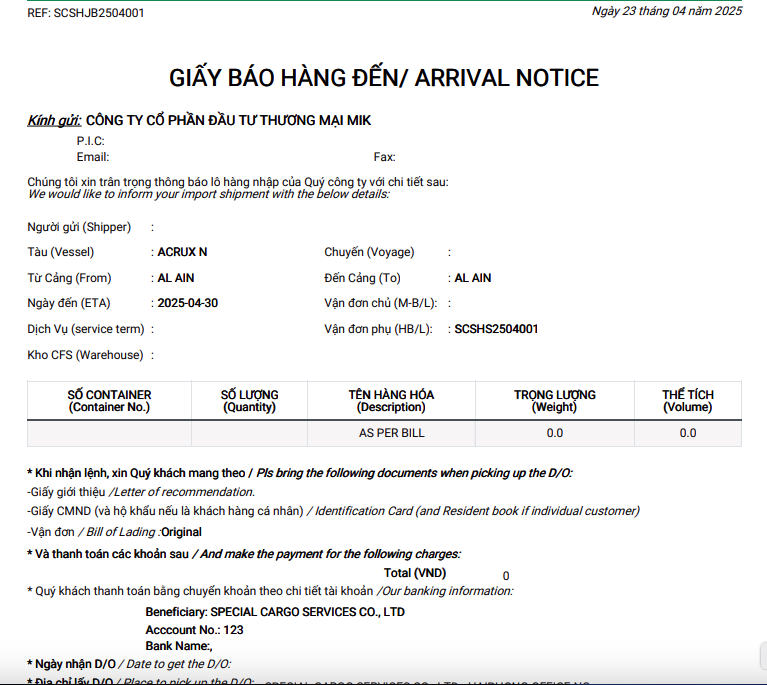
All documentation undergoes thorough verification for accuracy and validity and is submitted within the stipulated timeframe to mitigate potential risks of delays in customs clearance and cargo delivery.
6. Billing & Payment
Upon the complete execution of the transportation service and successful handover of goods to the consignee, the accounting department will proceed with invoicing and accounts receivable management in accordance with the agreed-upon terms with the customer.
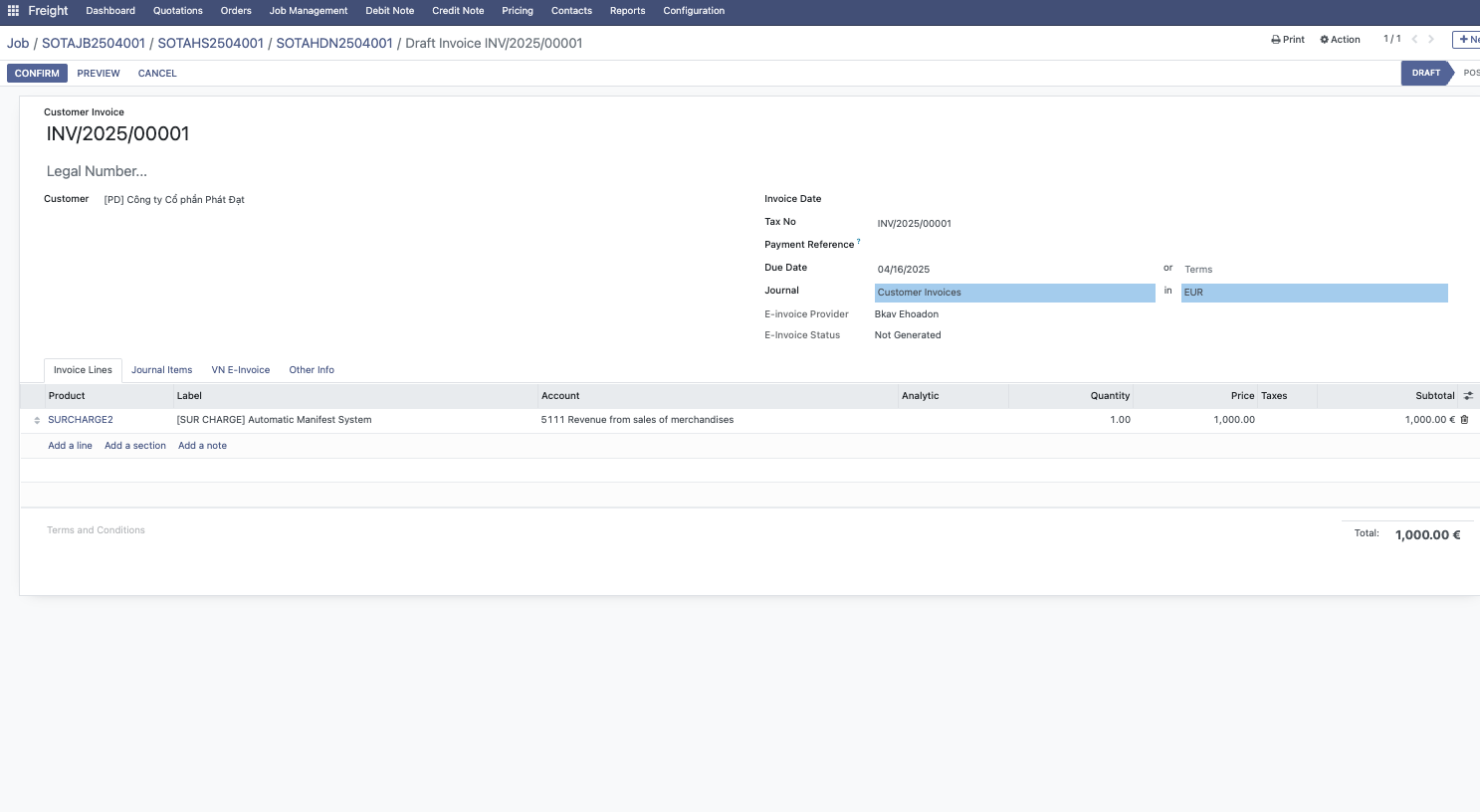
The specific steps involved are as follows:
Invoice generation:
- The accounting department will generate the official invoice based on the customer-confirmed quotation and any actual incurred costs (if applicable).
- The invoice content will include: order reference number, service description, detailed freight charges, VAT (if applicable), buyer and seller information, payment terms, etc.
Invoice delivery:
- Electronic copies will be sent via email or shared management platforms (ERP, Zalo OA, CRM systems, etc.).
- Upon customer request, hard copies can be sent via postal mail or delivered directly.
Accounts receivable monitoring & payment confirmation:
- The accounting/customer service department will monitor payment status according to the agreed-upon timeframe (e.g., immediate payment, 7 days, 30 days, etc.).
- Payment reminders will be sent as deadlines approach, and any issues related to reconciliation, document verification, or incorrect invoices will be addressed.
- Payment confirmation will be processed upon receipt of funds from the customer, and the accounts receivable status will be updated in the accounting system accordingly.
Accurate and transparent invoice and payment management not only ensures healthy cash flow for the business but also demonstrates professionalism and reliability in the collaborative relationship with customers.
7. Order closure & reporting
Upon completion of the transportation process and confirmation of payment, the final stage in the workflow is order closure and summary reporting. This critical phase enables the business to evaluate processing efficiency, control costs, and archive information for future transactions.

Key activities within this stage include:
Document archiving and management:
- All order-related documentation (bill of lading, invoices, Certificate of Origin (C/O), contracts, delivery receipts, payment invoices, etc.) is systematically organized and archived.
- Storage can be in hard copy format (printed) or soft copy format (scanned/PDF) within the electronic system to facilitate future retrieval and ensure regulatory compliance.
ERP management software data updates:
- Information regarding the order, transportation route, actual costs, revenue, and profit margins is consolidated and entered into the management system (ERP, TMS, etc.).
- The system automatically generates analytical reports on processing performance, on-time delivery rates, incurred costs, and profitability per shipment, customer, or route.
Feedback and issue resolution (if applicable):
- Proactive communication with the customer is initiated to confirm the smooth execution of the transportation process and gather feedback on service quality.
- In the event of complaints, errors, missing documentation, or unforeseen issues, the Customer Service (CS) department collaborates with relevant parties to investigate, resolve, and learn from the experience.
- Feedback is recorded to drive continuous improvement in operational processes for subsequent orders.
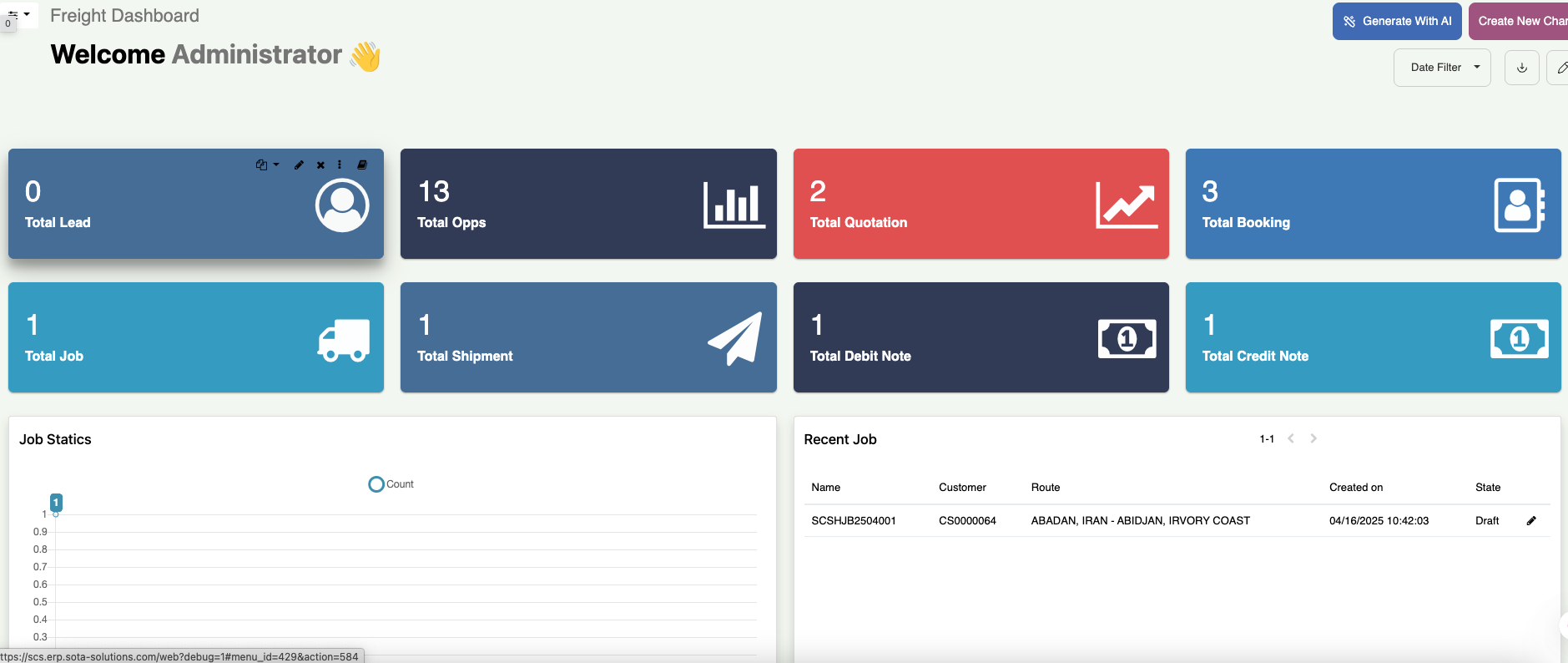
Order closure is not merely the finalization of a single order; it serves as the foundation for building a professional operational system, ensuring financial transparency, and enhancing customer service quality.
8. Benefits of implementing ERP in sales logistics processes

Enhanced efficiency and error reduction
Manual process handling is prone to inaccuracies in data entry, inventory calculations, order status updates, or incorrect product delivery. An ERP system facilitates:
- End-to-end automation, from lead management and order creation to inventory control, shipping, and payment.
- Minimized human error, ensuring high accuracy at each stage of the process.
- Reduced processing time, allowing personnel to concentrate on strategic tasks rather than manual operations.
Seamless integration of the entire process within a unified system
Instead of utilizing disparate software solutions for individual departments, ERP enables:
- Smooth connectivity between sales, warehouse, transportation, and accounting departments, ensuring continuous and uninterrupted information flow.
- Consistent data across the entire system, minimizing redundant data entry and ensuring all departments operate on a single data platform.
- Enhanced internal collaboration, improved coordination capabilities, and shortened order processing times.
Real-time data management
With ERP, all information within the logistics chain is updated continuously and accurately, empowering businesses to:
- Monitor order status, inventory levels, and delivery progress at any time.
- Make rapid and informed decisions based on real-time data rather than estimations or delayed reports.
- Mitigate redundant processing or the "where is my order?" scenario – a common challenge for businesses with unsynchronized systems.
Improved customer experience
Customers increasingly expect rapid delivery, transparency, and accuracy. ERP assists businesses in:
- Ensuring on-time delivery through precise warehouse, order, and logistics management.
- Providing comprehensive and timely updates to customers regarding their order progress (via email, SMS, or a tracking system).
- Boosting satisfaction and trust through professional, consistent, and unified service from order placement to delivery.
9. Conclusion
In summary, the implementation of ERP in sales logistics processes yields numerous tangible benefits: from effective lead management and accurate order processing to optimized transportation and warehousing, and performance analysis for informed decision-making. The seamless collaboration between sales and logistics departments, facilitated by the integrated power of ERP, not only saves businesses time and costs but also significantly enhances customer satisfaction. If you are seeking a solution to optimize your sales logistics processes, seriously consider implementing a suitable ERP system. This is not merely an investment in technology but an investment in the long-term growth and success of your business. Contact us for consultation and to receive materials on the latest technology trends.